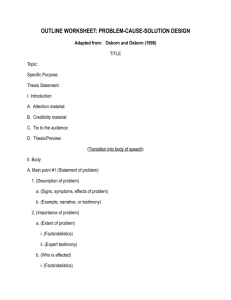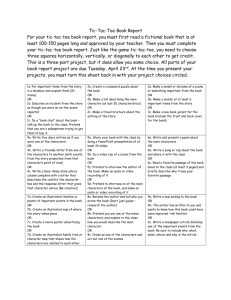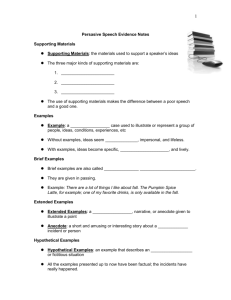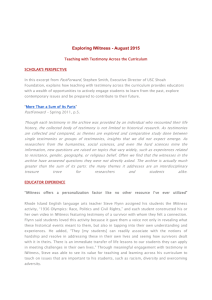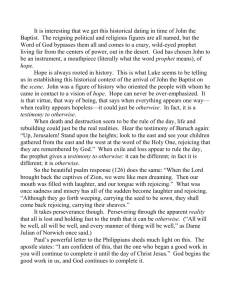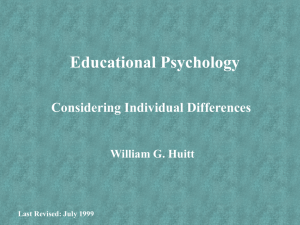Putting It All Together: Special Education Examples
advertisement
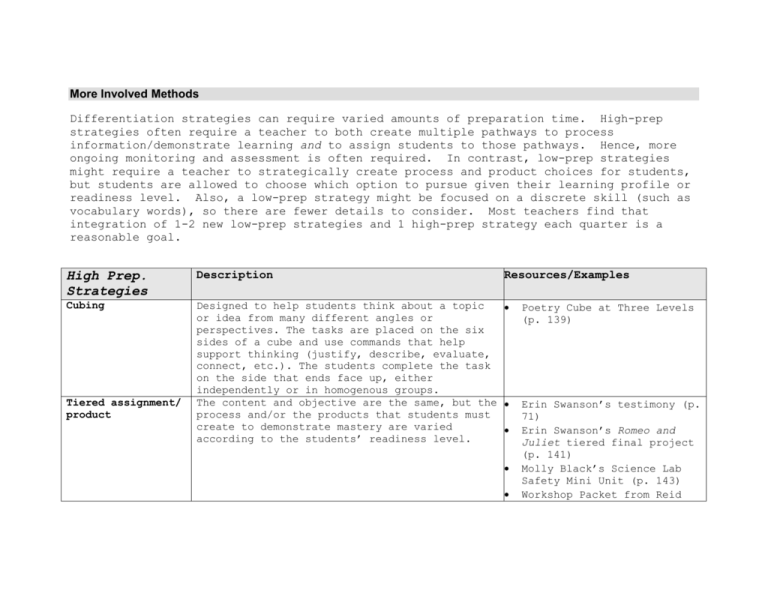
More Involved Methods Differentiation strategies can require varied amounts of preparation time. High-prep strategies often require a teacher to both create multiple pathways to process information/demonstrate learning and to assign students to those pathways. Hence, more ongoing monitoring and assessment is often required. In contrast, low-prep strategies might require a teacher to strategically create process and product choices for students, but students are allowed to choose which option to pursue given their learning profile or readiness level. Also, a low-prep strategy might be focused on a discrete skill (such as vocabulary words), so there are fewer details to consider. Most teachers find that integration of 1-2 new low-prep strategies and 1 high-prep strategy each quarter is a reasonable goal. High Prep. Strategies Description Cubing Designed to help students think about a topic or idea from many different angles or perspectives. The tasks are placed on the six sides of a cube and use commands that help support thinking (justify, describe, evaluate, connect, etc.). The students complete the task on the side that ends face up, either independently or in homogenous groups. The content and objective are the same, but the process and/or the products that students must create to demonstrate mastery are varied according to the students’ readiness level. Tiered assignment/ product Resources/Examples Poetry Cube at Three Levels (p. 139) Erin Swanson’s testimony (p. 71) Erin Swanson’s Romeo and Juliet tiered final project (p. 141) Molly Black’s Science Lab Safety Mini Unit (p. 143) Workshop Packet from Reid Independent studies 4MAT Students choose a topic of interest that they are curious about and wants to discover new information on. Research is done from questions developed by the student and/or teacher. The researcher produces a product to share learning with classmates. Teachers plan instruction for each of four learning preferences over the course of several days on a given topic. Some lessons focus on mastery, some on understanding, some on personal involvement, and some on synthesis. Each learner has a chance to approach the topic through preferred modes and to strengthen weaker areas. Jigsaw Students are grouped based on their reading proficiency and each group is given an appropriate text on a specific aspect of a topic (the economic, political and social impact of the Civil War, for example). Students later get into heterogeneous groups to share their findings with their peers, who have Whitaker (p. 210 for description) Friction: Roller Boxes (structured, guided, and open directions for students) (p. 145) Example of a Tiered Science Activity (p. 149) Tiered Assignments in 2nd Grade (p. 153) Classroom Example – Corey Berg (p. 195) Classroom Example - Ms. Jennifer Whitenack (p. 195) Classroom Example – Ms. May (p. 195) 4MAT About Teaching, by Bernice McCarthy Multiple texts Alternative assessments Modified Assessments Learning contracts or Personal Agendas read about different areas of study from source texts on their own reading levels. The jigsaw technique allows you to tackle the same subject with all of your students while discreetly providing them the different tools they need to get there. The teacher obtains or creates a variety of texts at different reading levels to assign strategically to students. After completing a learning experience via the same content or process, the student may have a choice of products to show what has been learned. This differentiation creates possibilities for students who excel in different modalities over others (verbal versus visual). Assessments can be modified in a variety of ways – for example by formatting the document differently (e.g. more space between questions) or by using different types of questions (matching vs. open ended) or by asking only the truly essential questions. A contract is a negotiated agreement between teacher and student that may have a mix of requirements and choice based on skills and understandings considered important by the teacher. A personal agenda could be quite similar, as it would list the tasks the teacher wants each student to accomplish in a given day/lesson/unit. Both Learning contracts and personal agendas will likely vary between students within a classroom. Natalie Webb’s video clip Matt Kelley’s testimony (p. 81) Mr. LP’s Learning Café Menu Activities (p. 155) Audrey Simmons’ Science Choice Agenda (p. 101) Explorer’s Extravaganza (p. 157) Sam Reheard’s testimony (p. 63) Jee Park’s testimony (p. 77) Sample modified assessments from Sam Reheard (p. 165) and Jee Park (p. 167) Learning Contract: The Light in the Forest (p. 173) Abnormal Psychology Learning Contract (p. 174) Handwriting Wheel (personal agenda) (p. 175) Mr. LP’s Learning Café Menu Activities (could also be considered a personal agenda) (p. 155) Compacting Literature circles This strategy begins with a student assessment to determine level of knowledge or skill already attained (i.e. pretest). Students who demonstrate proficiency before the unit even begins are given the opportunity to work at a higher level (either independently or in a group). Flexible grouping of students who engage in different studies of a piece of literature. Groups can be heterogeneous and homogeneous. Readers’ Workshop (Writers’ Workshop is a parallel strategy) The Readers’ Workshop approach involves students in three types of activities: Mini-lessons (5-10 minutes) on some aspect of literature or a reading strategy. Independent Reading Time (30-40 minutes), Algebra 1 Chapter 4 Learning Goals (p. 177) 30 Ways to Practice Your Spelling Words (p. 105) Spelling Record (p. 107) Erin Swanson’s packet of student handouts entitled “Literature Circles At a Glance” (p. 179) Recommended workshop packets by Jabari Sims & Abena Osei, and by Taylor Ramsey (p. 210 for an overview) Classroom Example – Mrs. Wilkerson (p. 195) http://facstaff.seattleu.edu/kschlnoe/ LitCircles/ (an extremely comprehensive site with lots of examples and strategies for literature circles) Matt Kelley’s testimony (p. 81) Jenny Beahrs’ testimony (p. 47) Stations/ Learning Centers where students keep a journal and respond to the literature in terms of what they think or how they feel about what they are reading. Sharing Time (10 minutes), where students share with another person their journal entries and the other person gives feedback. A station (or simply a collection of materials) that students might use independently to explore topics or practice skills. Centers allow individual or groups of students to work at their own pace. Students are constantly reassessed to determine which centers are appropriate for students at a particular time, and to plan activities at those centers to build the most pressing skills. Recommended workshop packets by Josh Wetterhan and Emily Mantel (p. 210 for an overview) Workshop packets by Kat Mathers, Eileen Chao, Kristin Muir and Leigh Kincaid (p. 210 for an overview) Classroom Example from Ms. Minor (p. 195) Daily Reading Center Schedule (p. 187) Center Activities (p. 188) Reading Centers Checklist (p. 189) (explained in Sharon Rubright’s video clip) Kathleen Watt’s testimony (p. 59) Anne Pennington’s testimony (p. 35) and video clip Sharon Rubright’s testimony (p. 53) and video clip Sharon Rubright and Anne Pennington’s video clips Center Activities (Listening Center in particular) (p. 188) Tape recorded materials at different levels Books on tape are purchased or (created by the teacher) so that students can listen to the book being read aloud to them while they follow along in the text. This is often done at a listening station, where tapes of books/information on various reading levels are available. Tic-Tac-Toe Choice Board (sometimes called “Think-TacToe”) Choice Boards The tic-tac-toe choice board is a strategy that enables students to choose multiple tasks to practice a skill, or demonstrate and extend understanding of a process or concept. From the board, students choose (or teacher assigns) three adjacent or diagonal. To design a tic-tac-toe board: - Identify the outcomes and instructional focus - Design 9 different tasks - Use assessment data to determine student levels - Arrange the tasks on a tic-tac-toe board either randomly, in rows according to level of difficulty, or you may want to select one critical task to place in the center of the board for all students to complete. Work assignments are written on cards that are placed in hanging pockets. By asking students to select a card from a particular row of pockets, the teacher targets work toward student needs yet allows student choice. Tic-Tac-Toe Choice Board: Using Persuasion to Address a Contemporary Issue (p. 191) Middle Ages Tic-Tac-Toe (p. 192) Insect Think-Tac-Toe (p. 193) See Tic-Tac-Toe strategies above – what is written on the board is instead written on cards and placed in pockets for students.
